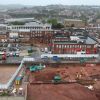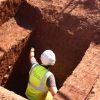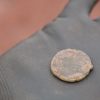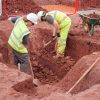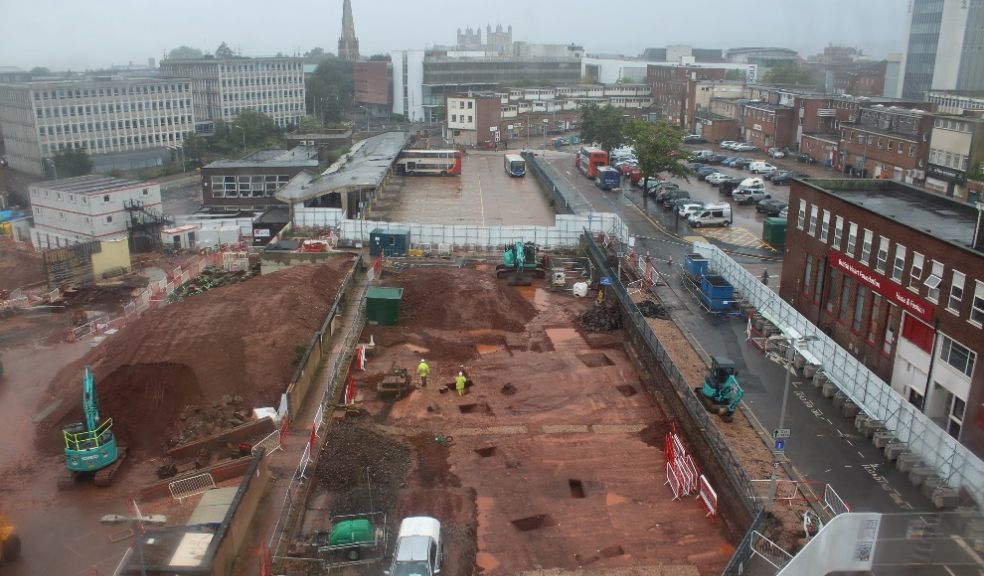
Remains of Roman defences discovered under Exeter’s Bus Station site
Archaeologists working on the redevelopment of Exeter’s bus station have uncovered the remains of a Roman fort.
The find has been described by an archaeology expert as “very important and completely unexpected.”
The discovery was made by the Exeter Office of Cotswold Archaeology who are working with Kier Construction to record remains of the city’s Roman history ahead of the construction of a new bus station and leisure complex.
The archaeology work will not impact on the construction timetable.
The finds, which include coins and local pottery made in the area for the military, as well as fine red Samian tableware imported from France will be studied, and the results published.
First to be uncovered was a Roman ditch at the top end of the site between Bampfylde Street and Cheeke Street. Further excavations revealed two further large Roman ditches running parallel to each other. Experts have revealed that these belong to a new, and completely unknown, Roman military site, either a fort occupied by a military unit, or a defended depot or compound.
Both are typical Roman military ditches. The outer, eastern one has a steep V shaped profile, with a deep “ankle breaker” trench along the bottom. The inner, western one is larger and deeper, and would have been immediately in front of a rampart above it to the west. It has a much steeper, near vertical, outer side, which was designed to trap any attackers who got this far and to leave them at the mercy of the defenders on the rampart above. It also has a deep ankle breaker trench.
The inside of the fort, or depot or compound, was to the west of these ditches, under the rest of the bus station, and under Bampfylde Street and probably Sidwell Street. The other sides of it have yet to be discovered.
Andrew Pye of Exeter City Council said: “This is a very important, and completely unexpected, discovery, in an area that has been heavily changed by previous post war redevelopment. Along with other recent work in Exeter, it demonstrates just how much of the city’s history can still survive in unlikely places, despite damage caused by bombing and modern concrete foundations.
“As the city continues to grow and renew, it is a good example of how the planning system and developers work together to make sure that remains that are inevitably affected by new development are properly excavated and recorded for the benefit of this and future generations.”
“This discovery of yet another new Roman “fort” within the city does demonstrate, along with that of the fortress and baths back in the 1970s and of several other new major military sites in the last decade, just how pivotal a role the Exeter area played in the first decades of the Roman conquest and subjugation of Britain, and how crucial development led archaeology has been in revealing this.”
Derek Evans, of Cotswold Archaeology’s Exeter Office, said: “We’re very pleased to be working with Kier and Exeter City Council on this important site. The unexpected nature of this discovery and the significance of uncovering previously-undocumented Roman military features in this area of the city, have made this a challenging and interesting project. We look forward to undertaking further analysis of the finds and other material recovered during our works and refining the story of the site’s history.”
Background
In the years following their invasion in AD 43 the Romans pushed forward into the South West and elsewhere, and established a legionary fortress at Exeter in around AD 55. This was garrisoned by up to 5,500 men of the 2nd Augusta legion. At the same time a network of roads and smaller forts was established throughout Devon and Cornwall. In around AD 75 the army left the SW for South Wales, and the forts and fortress were demolished, and a civilian town established at Exeter as the regional capital. A century later the town was defended by a city wall, which can still be seen today.
Following the discovery in the 1970s of the fortress and of its bathhouse under the Cathedral Green, more recent work undertaken by archaeologists working for developers has uncovered major new discoveries around the city, including a large and important building on Mount Dinham, in St David’s, another fort under Princesshay and Southernhay, a large defended military depot on the former St Loyes College site on Topsham Road, a small fort and other military type buildings at Topsham, and now another fort or defended compound in St Sidwells.
Investigations on the site of the new bus station and leisure centre have confirmed that any remains that were present were destroyed over most of the site by the construction of the present bus station back in the early 1960s, when there was no planning requirement for developers to record remains.











